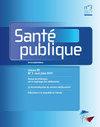Évaluation du dispositif Tuto’Tour de la grossesse chez les femmes fumeuses enceintes vulnérables
IF 0.3
4区 医学
Q4 PUBLIC, ENVIRONMENTAL & OCCUPATIONAL HEALTH
引用次数: 0
Abstract
INTRODUCTION In France, pregnant women generally receive written information about their pregnancy. The efficacy of these materials is limited for socially disadvantaged women, who are more likely to have lower levels of health literacy. As an alternative tool, awareness-raising videos have become popular, and the “Tuto’Tour de la grossesse” health promotion intervention has been created, which includes videos about smoking. The study objective was to evaluate the acceptability, usability, and accessibility of two videos about smoking among pregnant smokers in vulnerable situations. METHODS We conducted semi-structured interviews with these women, using a participatory approach. We then carried out a hybrid qualitative analysis, combining an analysis based on a conceptual framework and an inductive analysis. RESULTS Out of twenty participants, nine were separated from their child’s father and nine were unemployed. Twelve participants had less than a baccalaureate level of education and seven had a mother tongue other than French. Participants found the videos acceptable, usable, and accessible. We received positive feedback about the efficacy of the videos in terms of participants’ ability, opportunity, and motivation to change their behavior. Suggestions for improving the videos were made. CONCLUSIONS Other studies have looked at health promotion with similar interventions, but acceptability, usability, and accessibility have not been tested with socially disadvantaged women. These videos, which are acceptable, usable, and accessible to socially disadvantaged people, seem to have an influence on two out of three factors leading to behavior change. They could now be tested on a larger scale in a randomized controlled study.评估针对易受影响的怀孕吸烟者的 Tuto'Tour 妊娠工具
引言 在法国,孕妇一般都会收到有关怀孕的书面资料。这些材料对社会弱势妇女的效果有限,因为她们的健康知识水平更低。作为一种替代工具,宣传视频已成为一种流行趋势,"Tuto'Tour de la grossesse "健康促进干预项目就是其中之一。本研究的目的是评估处于弱势的怀孕吸烟者对两部吸烟视频的接受度、可用性和可及性。然后,我们进行了混合定性分析,将基于概念框架的分析与归纳分析相结合。结果 在 20 名参与者中,9 人与孩子的父亲分居,9 人失业。12 名参与者的教育程度低于高中毕业水平,7 名参与者的母语不是法语。参与者认为视频是可接受的、可用的和可访问的。我们收到了积极的反馈,认为视频在参与者改变行为的能力、机会和动机方面效果显著。结论:其他研究也采用类似的干预措施来促进健康,但尚未对社会弱势妇女的可接受性、可用性和可访问性进行测试。这些视频对于社会弱势群体来说是可接受的、可用的和可获得的,似乎对导致行为改变的三个因素中的两个产生了影响。现在可以通过随机对照研究对其进行更大规模的测试。
本文章由计算机程序翻译,如有差异,请以英文原文为准。
求助全文
约1分钟内获得全文
求助全文
来源期刊

Sante Publique
PUBLIC, ENVIRONMENTAL & OCCUPATIONAL HEALTH-
CiteScore
0.40
自引率
33.30%
发文量
252
审稿时长
>12 weeks
期刊介绍:
La revue Santé Publique s’adresse à l’ensemble des acteurs de santé publique qu’ils soient décideurs,
professionnels de santé, acteurs de terrain, chercheurs, enseignants ou formateurs, etc. Elle publie
des travaux de recherche, des évaluations, des analyses d’action, des réflexions sur des interventions
de santé, des opinions, relevant des champs de la santé publique et de l’analyse des services de
soins, des sciences sociales et de l’action sociale.
Santé publique est une revue à comité de lecture, multidisciplinaire et généraliste, qui publie sur
l’ensemble des thèmes de la santé publique parmi lesquels : accès et recours aux soins, déterminants
et inégalités sociales de santé, prévention, éducation pour la santé, promotion de la santé,
organisation des soins, environnement, formation des professionnels de santé, nutrition, politiques
de santé, pratiques professionnelles, qualité des soins, gestion des risques sanitaires, représentation
et santé perçue, santé scolaire, santé et travail, systèmes de santé, systèmes d’information, veille
sanitaire, déterminants de la consommation de soins, organisation et économie des différents
secteurs de production de soins (hôpital, médicament, etc.), évaluation médico-économique
d’activités de soins ou de prévention et de programmes de santé, planification des ressources,
politiques de régulation et de financement, etc
 求助内容:
求助内容: 应助结果提醒方式:
应助结果提醒方式:


